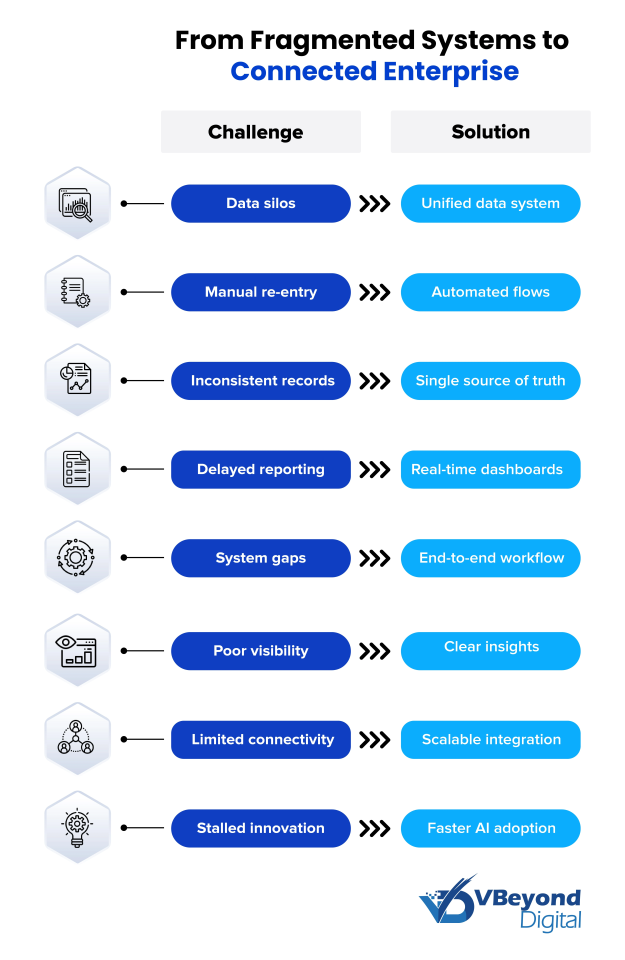Speeding up Digital Transformation for SMBs with Low-Code Power Platform and Business Central
Section
Table of Contents
- Why Move to Integrated Systems as an SMB?Where Traditional Pipelines Fall Short
- Power Platform and Business Central: Use Cases and Benefits for SMBs
- Data Visibility and Insights: Turning Siloed Data into Smart Decisions
- Conclusion: Clarity, Speed, and Outcomes with the Right Partner
- FAQs ( Frequently Asked Questions)
Why SMB Digital Transformations Struggle: Many initiatives fall short due to disconnected systems, limited scalability, and poor data visibility. These barriers drain resources and prevent businesses from realizing the full value of their investments.
The Power of Integration: Microsoft Power Platform and Dynamics 365 Business Central unify operations, automate workflows, and provide real-time insights. Together they eliminate silos, streamline processes, and create a single source of truth for smarter decisions.
Scaling with Confidence: Cloud-native solutions adapt as SMBs grow, supporting higher data volumes and new business needs without costly reengineering or downtime. This ensures technology investments continue to deliver value over time.
The Outcome: With integrated, scalable tools, SMBs gain enterprise-grade capabilities in a practical and affordable way, enabling them to move faster and compete more effectively.
For small and midsize businesses (SMBs), the path to digital transformation can feel overwhelming. Budgets are tighter, teams wear multiple hats, and legacy systems often slow down progress. At the same time, customers expect fast, seamless, and personalized experiences. The challenge is not only about adopting new technology, but also about selecting the right solutions that simplify operations, scale as the business grows, and empower employees to make smarter decisions.
Research has found that up to 70% of digital transformation projects do not meet their goals. This gap between ambition and outcome is often caused by a common set of challenges: fragmented systems that do not talk to each other, solutions that do not scale as the business grows, lack of visibility into data, and workforce skill gaps and resistance to change. Technology is only part of the puzzle, success also hinges on strategy, integration, and people.
Tempering the pace of transformation by adopting solutions catering to small and midsize businesses ensures that budgets do not overrun with expensive systems that are too complex to deploy and deliver value. Microsoft Power Platform and Dynamics 365 Business Central work together as a powerful combination for SMBs. Business Central provides a unified, cloud-based ERP system to manage finance, supply chain, sales, and operations. Power Platform enables rapid app development, workflow automation, data analysis, and AI-driven insights. For SMBs, this integration represents a practical and affordable way to accelerate transformation, bridging gaps between disconnected systems and unlocking efficiency across the organization.
Why Move to Integrated Systems as an SMB?
One of the most persistent pain points in enterprise IT is system integration. Over the decades, large organizations have accumulated patchwork of applications. From legacy ERP systems to cloud SaaS tools, that often operate in silos.
The Challenge of Integration
- Siloed systems: Enterprises often have a patchwork of legacy ERP systems and modern SaaS tools that don’t communicate.
- The scale of the problem:
- 95% of enterprises struggle to integrate data across disparate systems.
- The average enterprise uses 897 applications, but only 29% are integrated.
- Impact of silos:
- 82% of enterprises report that data silos disrupt workflows.
- Knowledge workers lose 12 hours per week searching for information across disconnected systems.
- This results in lost productivity, higher error rates, and lack of a single source of truth.
Accelerate SMB digital transformation with the right strategic partner.
The Benefits of Integration
Business efficiency & agility
- Strong integration yields 10.3x ROI from AI and analytics (vs. 3.7x for poorly connected firms).
- Organizations that overcome integration barriers deploy AI 4x faster and extract 3x more value.
Day-to-day improvements
- A single source of truth for data: real-time dashboards and accurate reports.
- Better customer service: unified views of customer history, support tickets, and orders.
- Process automation: e.g., triggering ERP order fulfillment when online payments are confirmed.
Strategic impact
- Eliminates errors and inefficiencies from manual data handling.
- Future-proofs IT architecture with easier onboarding of new apps.
- Provides a foundation for AI, advanced analytics, and digital innovation.
- A unified data environment with consistent, real-time information.
- Faster process cycles as data flows seamlessly across systems.
- The ability to launch new services and leverage AI insights effectively.
- More confident, data-driven decision-making with fewer blind spots.

Power Platform and Business Central: Use Cases and Benefits for SMBs
Most SMBs face the same core challenges: siloed data, manual processes, limited IT resources, and difficulty scaling without adding complexity. Power Platform and Business Central address these issues head-on by working as one system. Business Central manages critical operations, while Power Platform unlocks automation, analytics, and customization that fit each unique business. The result is efficiency, agility, and insight, all built on a single connected foundation.
1. Streamlined Operations
- Integrated Workflows: Tasks like invoice approvals, purchase order creation, or inventory alerts are automated by linking Business Central with Power Automate. Instead of bouncing between different apps or re-entering data, the system handles it automatically.
- Custom Apps on Demand: With Power Apps, SMBs can extend Business Central with small, tailored apps that fill process gaps, such as a mobile inspection checklist for field staff or a vendor portal for purchase requests.
When workflows and apps connect directly into Business Central, operations run end-to-end without manual effort. This reduces errors, speeds up cycle times, and allows SMBs to do more with smaller teams.
2. Real-Time Data Visibility and Insights
- Unified Dashboards: Power BI transforms Business Central data into interactive dashboards for finance, sales, and operations. Executives can track cash flow, managers can monitor order status, and sales teams can see pipeline health in real time.
- Predictive Insights: AI models highlight risks such as late payments, bottlenecks, or low stock before they cause disruption.
Integration ensures that Business Central data flows seamlessly into Power BI, creating one source of truth across the business. Decisions are no longer based on partial or outdated reports, but on current and reliable insights. This lets SMBs act quickly, spot trends early, and compete on agility rather than size.
3. Enhanced Customer Experience
- 360-Degree Customer View: By combining customer history, orders, and support cases from Business Central with CRM apps built on Power Platform, teams can understand and anticipate customer needs.
- Faster Service Response: Power Automate can route support tickets, trigger service scheduling, or notify account managers when key customers log issues.
Integration allows customer-facing teams to access complete, connected information. This leads to faster responses, fewer errors, and more personalized service. SMBs can build the kind of customer trust and loyalty usually associated with larger, resource-rich competitors.
4. Scalability and Flexibility
- Adaptable Apps: Power Apps make it easy to add new capabilities when business requirements change, whether supporting an additional sales channel or complying with new regulations.
- Cloud-Native ERP: Business Central scales with the organization as data volumes and user counts grow, avoiding costly infrastructure upgrades.
Integration gives SMBs a future-proof system. Business Central provides stability, while Power Platform delivers the flexibility to adjust quickly. This means SMBs can grow and adapt without expensive reengineering or disruptive system changes.
5. Workforce Empowerment
- Employee-led Development: Power Platform enables employees in operations, finance, or sales to create apps or automate tasks without coding. For example, a finance team operative can build a simple app to track vendor payments that feeds back into Business Central.
- Upskilling Opportunities: Low-code tools foster digital literacy across the organization and help employees transition from repetitive work to higher-value tasks.
Integration ensures these employee-built solutions are not isolated or risky. They are directly connected to Business Central, which ensures that data is accurate, and processes are consistent. The workforce becomes more engaged, IT workloads are reduced, and innovation comes from every corner of the organization.
The Bigger Picture for SMBs
Power Platform and Business Central together create more than just efficiencies. They give SMBs the ability to run like larger enterprises while retaining the speed and personal touch of smaller organizations. Processes connect seamlessly, data flows without friction, and teams have the tools to act quickly and intelligently. For SMBs competing in dynamic markets, this integration levels the playing field and creates a foundation for sustainable growth.
Data Visibility and Insights: Turning Siloed Data into Smart Decisions
The Risks of Poor Data Visibility
- Decisions on Partial Information: Executives often rely on intuition because they lack comprehensive, real-time insights.
- Missed Opportunities: Trends like customer churn signals or process inefficiencies remain hidden in unexamined data.
- Conflicting Metrics: Departments using different versions of “the same” KPI create confusion and weaken strategy.
The result is a business culture where actions lag behind reality, undermining competitiveness.
Building the Foundation for Data-Driven Success
Becoming data-driven requires more than just dashboards. It calls for an infrastructure and culture where data is:
- Centralized: Consolidating information into a single source of truth through a data warehouse, data lake, or federated model.
- Clean and Consistent: Ensuring data quality through cleansing, standardization, and master data management so that identifiers (like customer IDs or product codes) align across systems.
- Accessible and Trustworthy: Providing secure access so teams can confidently use data in everyday decision-making.
Without these foundational steps, advanced analytics, AI, and predictive modeling remain out of reach.
Empowering Teams with Analytics Tools
Once the data is unified and trustworthy, the next step is enabling people to use it effectively. Modern business intelligence tools play a key role here:
- Interactive Dashboards: Role-based dashboards allow executives and managers to analyze what’s most relevant to them.
- Automated Pipelines: Reports update continuously instead of relying on manual data pulls.
- Self-Service Analytics: Business users gain independence in exploring data, reducing reliance on analysts for routine queries.
This shift transforms reporting cycles from weeks of manual effort to real-time dashboards, freeing teams to focus on interpretation and strategy.
Aligning Analytics with Business Goals
Data visibility only drives impact when linked to outcomes. That means identifying and prioritizing the key metrics (KPIs) that truly matter:
- If retention is critical, focus on churn rates, repeat purchase behavior, and loyalty drivers.
- For operational efficiency, track supply chain metrics like stockouts and excess inventory.
- In marketing, we measure conversion funnel drop-offs to pinpoint and resolve bottlenecks.
When analytics is tied to strategy, leaders stop drowning in numbers and start seeing the story data is telling.
The Measurable Impact of Data Visibility
Organizations that embrace data-driven practices achieve:
- 35% higher productivity and 25% better decision-making quality through stronger data literacy programs.
- Meetings that shift from opinion-based debates to fact-based discussions.
- Operational improvements such as reduced inventory waste, higher customer retention, and better forecasting accuracy.
The cultural shift is just as important. When employees see decisions grounded in data, accountability grows, and the instinct becomes: “What does the data show?”
Autonomous Anomaly Detection and Resolution
Advanced agentic systems provide context-aware detection that understands business operations to fine-tune detection algorithms, ensuring only meaningful anomalies trigger alerts. These systems move from reactive to proactive monitoring by using predictive analytics to forecast potential data issues before they occur.
An AI-powered observability platform connected to intelligent sensors can detect unexpected changes before they escalate while providing automated root-cause analysis that accelerates resolution by identifying upstream issues in minutes.
From Reactive to Proactive
With comprehensive visibility, businesses move beyond hindsight reporting. They can:
- Spot trends early (e.g., rising product demand, declining employee satisfaction).
- Apply predictive analytics to forecast churn, optimize maintenance, or anticipate market shifts.
- Innovate faster, with confidence that decisions rest on evidence, not assumptions.
Conclusion: Clarity, Speed, and Outcomes with the Right Partner
Enterprise technology leaders do not lack vision, they know where they want to take their organizations. The real challenge is execution: getting from strategy to tangible results amid complex IT landscapes, ever-changing technology, and organizational headwinds. The path to digital excellence doesn’t have to be a risky leap into the unknown. With the right approach and the right partner, you can accelerate into digital initiatives that are grounded in strategy and guided by experience, ensuring that each step delivers business value.
Your digital goals are within reach. With VBeyond Digital by your side, you can transform those goals into reality with the confidence that you’re building a smarter, faster, and more resilient business for today and for the years ahead. Let’s turn your transformation vision into the next success story. We help you get there faster, with less risk, and with results that speak for themselves.
FAQs (Frequently Asked Question)
For small and mid-sized businesses, digital change means shifting key processes from paper, email, or spreadsheets to connected apps, automation, and data. It replaces repetitive manual work with tools that share information, speed approvals, and give leaders clear visibility. Start small, prove value, then grow to more teams.
Microsoft Power Platform (Power Apps, Power Automate, Power BI, and Power Pages) lets you build apps, automate tasks, and report on data with click-and-drag tools. Prebuilt connectors tie into Microsoft 365, Dynamics, and popular SaaS. Results: faster cycles, fewer errors, and insights without hiring a large dev team.
Going digital reduces costs, shortens cycle times, and improves customer experience. It centralizes data for better decisions, cuts errors from re–keying, and helps teams work from anywhere. Competitors already invest in these capabilities; moving now protects margins, supports growth, and keeps your business responsive to market shifts.
Pick one high-friction process (approvals, service requests, inventory counts). Map the steps, define success, and build a small Power Apps app or a Power Automate flow with existing data. Pilot with 5–10 users, gather feedback, add security and governance, then roll out and measure time and error reductions.
A low-code platform helps small IT teams by sharing the workload with business users through templates and guided builders. IT sets data connections, security, and review gates; makers handle form fields, workflows, and reports. Built-in connectors and managed environments cut maintenance, so IT can focus on priorities.




